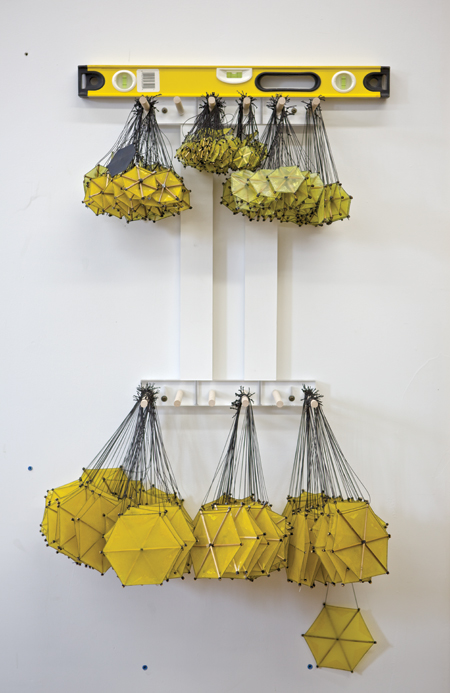
Jacob Hashimoto creates multifaceted installations using small paper kites. Some kites are patterned, others white and half-translucent; usually they hang together mid-air, like ghosts or little signs, or scales. Whether circular, hexagonal or cubic in form, kites are combined to create environments of color and ambient light. "This, multivalent, pan-cultural object," Hashimoto says, "creates a door into the work whereby a large and various audience feels comfortable entering and exploring a sense of possibility." Kites are common across the globe, from Japan, China, India and New Zealand to America and Europe. They have a way of being passed between cultures, and yet there is no clear origin story that describes their inception. Different countries have different kite-making styles. Born in Colorado in 1973, Hashimoto draws on Japanese tradition to construct his kites; he uses rice paper and bamboo, focusing on its potential to flit through associations. "The kite embodies a sense of play but also hubris, adventure, nostalgia, youth, tradition, and simplicity," he observes. Somehow Hashimoto employs these various connotations to create abstract landscapes that elicit an idea of nature. Hashimoto's new, two-part installation, Super-elastic collisions (origins, and distant derivations) will be on view at Rhona Hoffman Gallery this September in Chicago (he is based in New York, where he is represented by the Mary Boone Gallery).
"I don't think my intention is to create a substantive dialogue between the art and the architecture," Hashimoto admits. "Rather, I try to create new architectures within existing buildings." These delicate kites overwhelm interior space with color and pattern. His first piece, after which the title of the show is derived, will occupy the front of the gallery with roughly one thousand 12-by-12-by-12-inch plastic and wooden cubes. "Super-elastic is a crazy landscape exploration that touches on '70s conceptual sculpture, contemporary video games, sticker bombing, and the canonization of crappy materials." Typical of Hashimoto's work, Super-elastic... will incorporate recognizable landscape elements--grass and clouds, for instance--on different faces of cubes as they hang, seemingly frozen mid-tumble. In the back of the gallery, the viewer will step away from an earthbound perspective to encounter a vision of outer space. This second work, "Gas Giant, is going to be a big abstract cloud of floating cubes comprised of square, hexagonal, and circular kites. If it's successful, Gas Giant will make the viewer feel like he or she is standing in some kind of animated, color-coded supernova on a PBS documentary."
Despite the physical presence of string, one cannot help but feel like Hashimoto's landscapes are ethereal and disembodied. Even with their undeniably physical presence, kites are constructed to float with the wind. Although kites have been made for thousands and thousands of years, there is something very contemporary about Hashimoto's vision. It's as though he has figured out an analogue representation of digital space, one that feels both artificial and familiar. The kites function like pixels or screens; each one filters and reflects light. Additionally their evocation of the natural world comes from the artist's use of vernacular, cartoonish tropes--stalks of grass or stylized Hot Wheels flames--while being entirely removed from original, source material. In so doing he conjures a sense of nature while remaining exceptionally distant from it.
Part of Hashimoto's success lies in his ability to create an entire atmosphere. It's a little psychedelic: paper prints and patterns multiply in space, dream-like and hallucinatory. The visual impact of these pointillist screens, combined with the kite's intended function creates a means for psychological levitation. Hashimoto's kites are also vehicles for the imagination--they afford a cohesive experience that goes beyond our expectations. This world defies gravity. It is overwhelming and delicate all at once--ephemeral and tactile, bearing with it something sublime and flitting. Explains Hashimoto: "I like [the kite's] direct and fundamental bond to the chaos and unpredictability of the natural world."
This article was written for and published in art ltd. magazine ![]()
